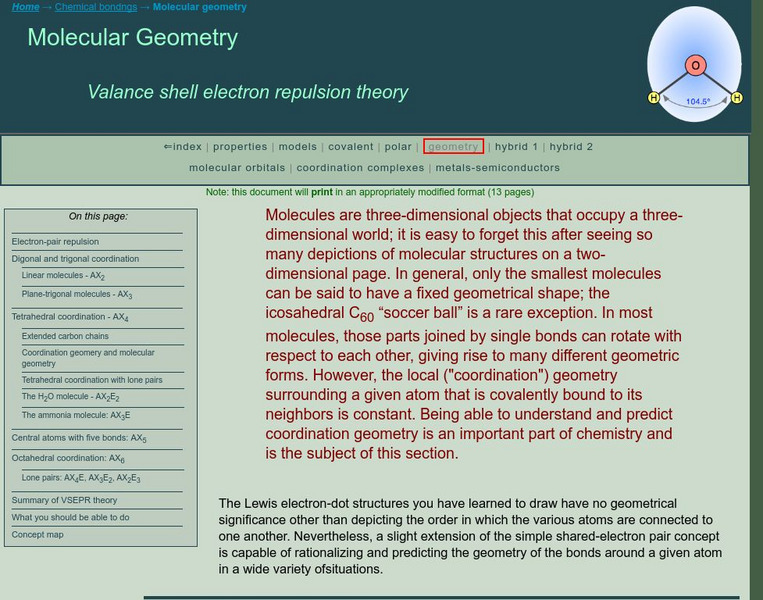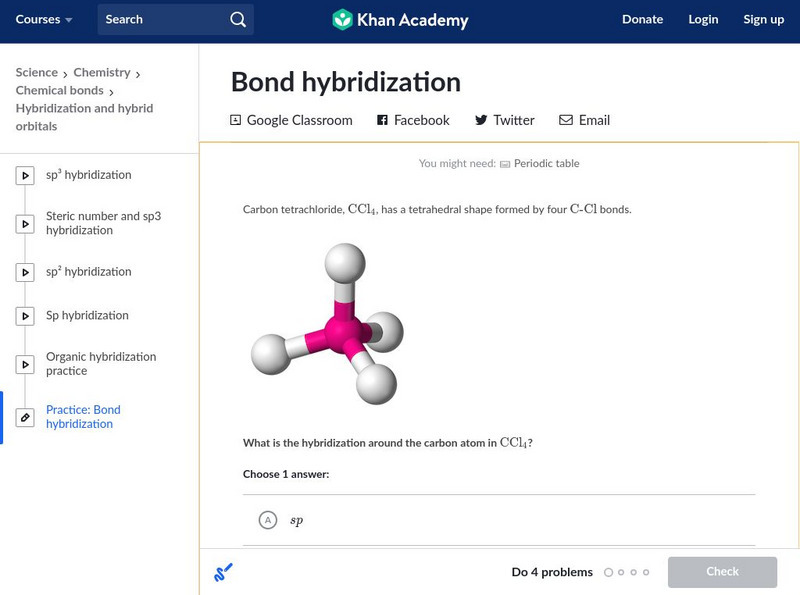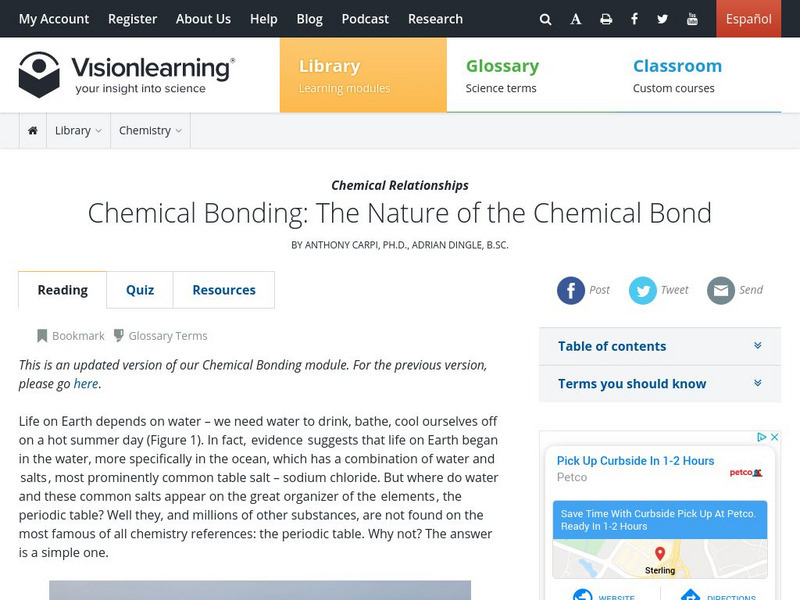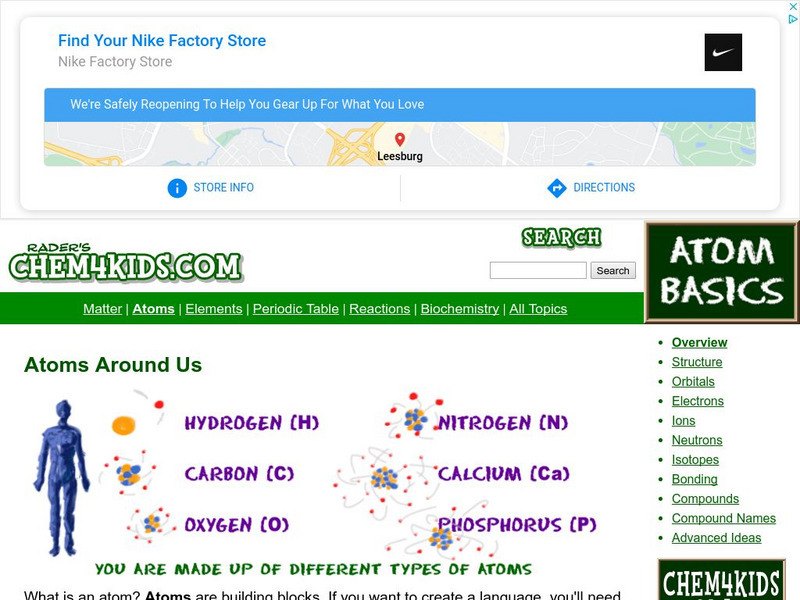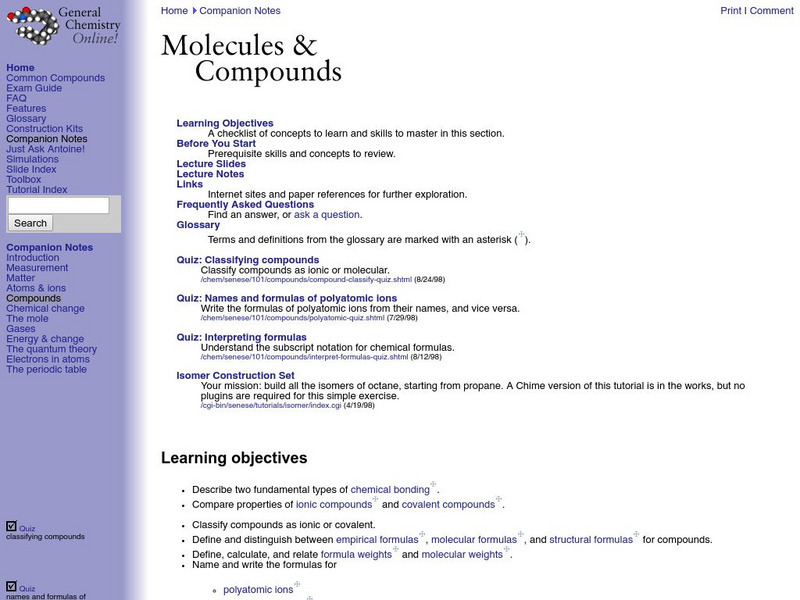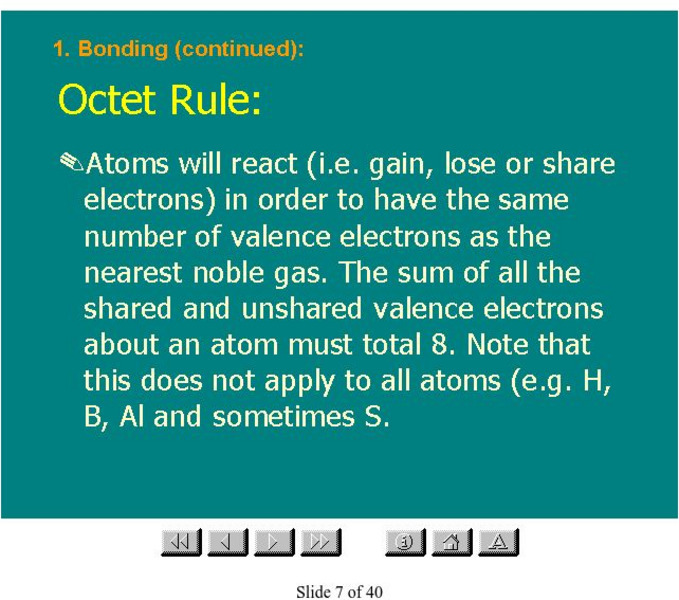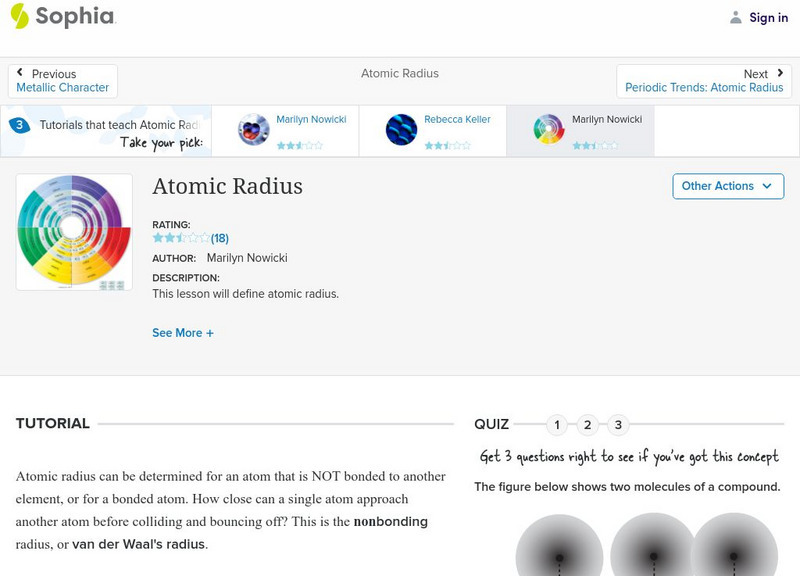Simon Fraser University
Chem1 Virtual Textbook: Bonding in Metals and Semiconductors
Acting as an overview from the General Chemistry Virtual Textbook, this site explores chemical bonding in relation to metals and semiconductors. Topics covered include molecular orbitals in metals, band structure in metals, and more.
Simon Fraser University
Chem1 Virtual Textbook: Molecular Geometry
An advanced explanation of the valence shell electron pair repulsion (VSEPR) theory describes specific molecular models involving digonal, trigonal, tetrahedral, and octahedral coordination, as well as central atoms with five bonds....
Simon Fraser University
Chem1 Virtual Textbook: Chemical Bonds: Covalent or Ionic or What?
Use this resource to understand polar covalence in ion-derived solids.
CK-12 Foundation
Ck 12: Molecular Geometry
[Free Registration/Login may be required to access all resource tools.] In this interactive learning module, students will learn a technique to predict molecular geometry based on a molecule's Lewis electron dot structure.
Khan Academy
Khan Academy: Bond Hybridization
Practice determining the hybridization for atoms in covalent compounds. Use the interactive scratch pad to work out the problems.
American Chemical Society
American Chemical Society: Hompage
ChemCenter, available from the American Chemical Society, provides chemistry news, reference sources and other public services.
Vision Learning
Visionlearning: Chemistry: The Nature of the Chemical Bond
This site talks about ionic, polar covalent, and non-polar covalent bonding.
Chem4kids
Chem4 Kids: Atoms
This site provides a detailed overview of atoms. Content explores an atom's structure, as well as what ions are, how atoms bond, what compounds are (including how to name compounds), and what isotopes are.
Frostburg State University
General Chemistry Online: Molecules and Compounds
A complete lesson on compounds, from introductory material in the beginning to a practice exam at the end. This lesson covers bonding, ionic compounds, molecular compounds, naming compounds, structural formulas, polyatomic ions, and much...
Iowa State University
Iowa State University: Percent of Water in a Crystalline Solid Hydrate
Lab activity uses a computer simulation to determine the amount of water in a crystalline solid hydrate.
Texas Instruments
Texas Instruments: Naming and Writing Formulas of Acids
This StudyCard activity will enable students to practice naming and writing formulas for binary and non-binary inorganic acids. This activity will also allow students to practice naming acids found in aqueous solution as well as those...
Science Education Resource Center at Carleton College
Serc: Marshmallow Models
This chemistry lesson will test learners' understanding of VESPR structures. They will use marshmallows and redhots to investigate molecules, acids, and polyatomic ions.
Science Education Resource Center at Carleton College
Serc: Investigating Diffusion of Molecules in Liquid
Scientific inquiry activity where students investigate how molecules move in liquid. They will observe that molecules in liquid move in a random manner and that heat will increase and cold will decrease the speed of molecular movement in...
Simon Fraser University
Chem1 Virtual Textbook: Molecular Orbitals
Acting as an overview from the General Chemistry Virtual Textbook, this site explores the topics related to molecular orbitals including bonding and antibonding MOs, molecular orbital diagrams, sigma and pi orbitals, and more.
Ohio State University
Ohio State University: Electronegativity & Bond Polarity
Excellent graphics help this page explain the relationship between electronegativity and bond polarity.
Michael Blaber, PhD
Fsu: Basic Concepts of Chemical Bonding: Exceptions to the Octet Rule
Lists the exceptions to the octet rule and provides a discussion and diagrams explaining each one. Includes clear diagrams illustrating this concept.
Michael Blaber, PhD
Florida State University: Basic Concepts of Chemical Bonding: Ionic Bonding
This tutorial explains the basic concepts of ionic bonding, with a good discussion of lattice energy.
PBS
Pbs: This Emotional Life: Attachment
PBS explores information on forming attachments including the types of attachments and the importance of each.
Other
Organic Chemistry: Octet Rule
This slide presentation contains a description of the octet rule, as well as many related topics.
Sophia Learning
Sophia: Atomic Radius: Lesson 3
This lesson will define atomic radius. It is 3 of 3 in the series titled "Atomic Radius."
Sophia Learning
Sophia: Chemical Reactions: Lesson 4
This lesson will present a basic understanding of the periodic chart of elements and how to predict chemical reactions based on given information. It is 4 of 9 in the series titled "Chemical Reactions."
CK-12 Foundation
Ck 12: Plix: Aspartame Molecule: Peptides
[Free Registration/Login Required] Given prior knowledge of bonding and the molecular make up of aspartame, examine the model and determine which color represents which atom. Drag the labels at the bottom to the appropriate colored atom...
Sophia Learning
Sophia: Molecular Structure of Water
A brief introduction to the molecular structure of a water molecule, and the chemical bonding which gives it its unique properties.
Other
University of Texas at Dallas: Attractions in Compounds
Explanation of attractive forces and energy changes involved in bonding.



